




OUR BEST EVER OFFER - SAVE £100/$100
JOIN THE WORLD'S LEADING PROFESSIONAL DEVELOPMENT PROGRAMME
- 12 months membership of Elite Soccer
- Print copy of Elite Player & Coach Development
- Print copy of The Training Ground
Attacking movement and interplay
This session helps improve movement and interplay between midfielders and forwards. It’s designed to encourage understanding between players through timing of runs, weight of pass, and expectation of a team mate’s movement.
| Area | Half pitch |
| Equipment | Balls, mannequins, goal |
| No. of Players | 5 (incl. a keeper) |
| Session Time | 7-8mins for each move, 3-4mins for each progression |
This session helps improve movement and interplay between midfielders and forwards. It’s designed to encourage understanding between players through timing of runs, weight of pass, and expectation of a team mate’s movement.
Building this understanding is vital for the creation of chances as a fluid unit, and this session offers a number of set-ups and progressions to test attacking and defending players in equal measure.
Each move takes place on a half pitch with four mannequins placed 8 yards apart across the pitch, 10 yards outside the penalty box. These represent the back four.
Move 1: quick wide attack
What do I get the players to do?
The coach starts the drill by laying the ball to the midfielder, who has two strikers moving off the mannequins and a winger out wide.
The midfielder plays the ball in to striker 1, whose double movement means he moves away then turns back sharply to receive the pass.
The striker lays the ball to his team mate who has moved deep to support. Timing of the pass is essential so that striker 2 can play a threaded pass between the centre-back and full-back mannequins for the wide man to run on to and cross.
The two strikers and midfielder make their way into the box for the cross. We now rerun on the opposite flank.
What are the key things to look for technically/tactically?
We must see good eye contact between the midfielder and striker 1. Passing moves are conducted at pace and with precision, so confident and well communicated link-up play is essential.
The double movement of striker 1 is important in terms of him losing his man – he goes long only to come back short.
The wide man needs to time his run well to ensure he stays onside in front of the line of mannequins, and a good weight of final pass and subsequent cross is essential.
1
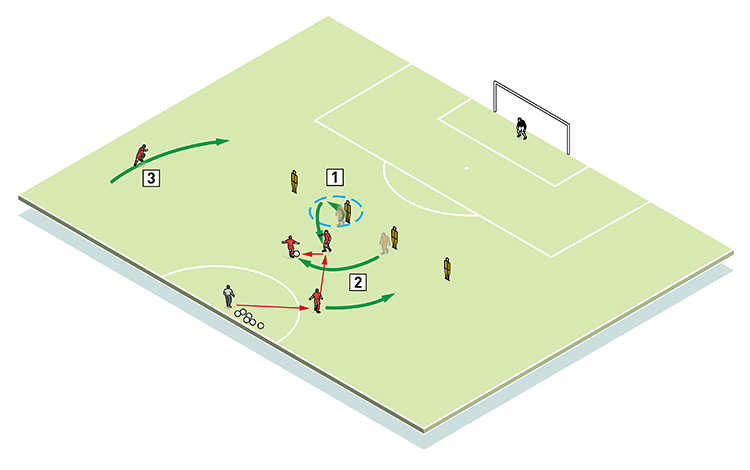
2. The second striker drops deep to receive
3. The wide man breaks forward to receive the pass
2
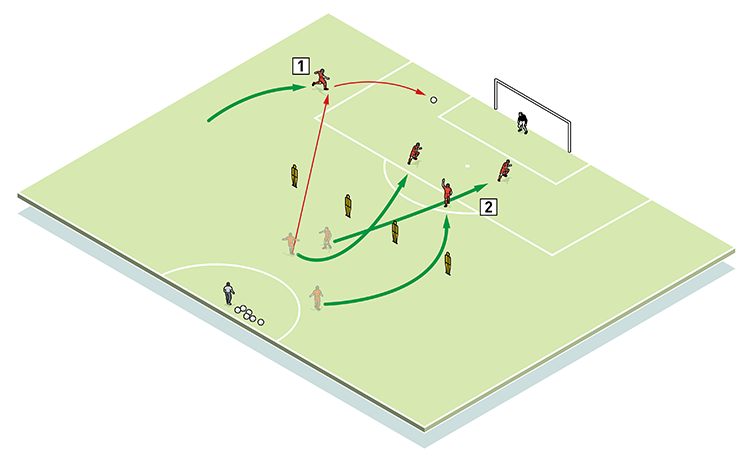
2. A floated cross invites the three players to attack the goal
Move 2: quick central attack
What do I get the players to do?
The coach starts the drill by laying the ball to the midfielder, who opens up with a first touch onto his right foot.
Striker 1’s movement sees him come short first, before spinning in behind the centre-back. The striker is picked out by the midfielder using either an aerial ball or a threaded pass along the floor that is run
on to.
At this point the wide man runs diagonally inside the mannequin, while striker 2 also makes a charge for
the box.
Striker 1 either takes the ball on himself to finish, or plays square for one of the other two inrushing players to finish.
What are the key things to look for technically/tactically?
Technique and weight of pass again come to the fore, particularly for the ball played by the midfielder into the feet of striker 1. This pass needs to be perfect so the frontman can take it in his stride. Again, if the striker goes too early he risks straying offside. Assuming he stays onside, it’s crucial that his wide man and fellow striker make positive and determined runs into the box for a potential finish. Again, we rerun on the opposite flank.
3

2. Striker 2 rolls his defender
3. A lofted ball picks out striker 1 with attacking team mates looking to support
4
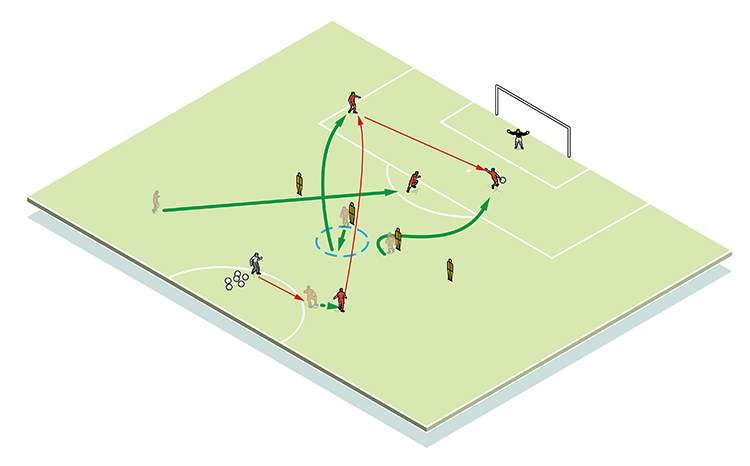
Move 3: measured central attack
What do I get the players to do?
In this move, we substitute the winger for an additional midfielder, positioned on the other side of the coach.
To start, the coach touches the ball to the midfielder, who opens up and plays to striker 1, whose movement is once again to fake going long before coming back short.
Striker 2 moves around the front to receive the lay-off from his team mate. He then plays an immediate pass through the back four for the second midfielder to run on to, who ensures he times his run well so as to receive the pass in his stride. The front two move forward looking to score.
Once finished, we direct the drill to the other side as in previous developments.
What are the key things to look for technically/tactically?
The central passing move is now tighter with an additional midfielder, and this increases the need for accurate and well-weighted passing throughout. The double movement of striker 1 remains important, as does the timing of the midfielder’s run breaking at pace through the defensive line, whilst ensuring he stays onside.
5
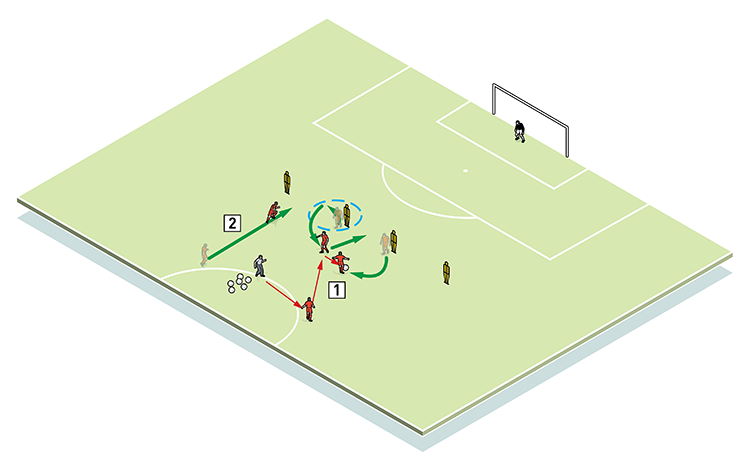
2. The midfielder makes a positive forward run
6
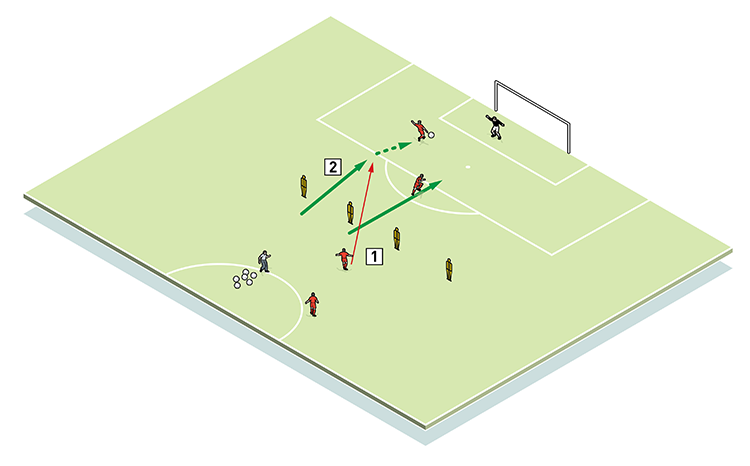
2. The supporting midfielder runs from deep to form a two-man attack
Related Files
Editor's Picks
Attacking transitions
Deep runs in the final third
Using the goalkeeper in build-up play
Intensive boxes drill with goals
Penetrating the final third
Creating and finishing
My philosophy
Pressing initiation
Compact team movement
Coaches' Testimonials

Alan Pardew

Arsène Wenger

Brendan Rodgers

Carlos Carvalhal

José Mourinho

Jürgen Klopp

Pep Guardiola

Roy Hodgson

Sir Alex Ferguson

Steven Gerrard
Coaches' Testimonials

Gerald Kearney, Downtown Las Vegas Soccer Club

Paul Butler, Florida, USA

Rick Shields, Springboro, USA

Tony Green, Pierrefonds Titans, Quebec, Canada
Join the world's leading coaches and managers and discover for yourself one of the best kept secrets in coaching. No other training tool on the planet is written or read by the calibre of names you’ll find in Elite Soccer.
In a recent survey 92% of subscribers said Elite Soccer makes them more confident, 89% said it makes them a more effective coach and 91% said it makes them more inspired.
Get Monthly Inspiration
All the latest techniques and approaches
Since 2010 Elite Soccer has given subscribers exclusive insight into the training ground practices of the world’s best coaches. Published in partnership with the League Managers Association we have unparalleled access to the leading lights in the English leagues, as well as a host of international managers.
Elite Soccer exclusively features sessions written by the coaches themselves. There are no observed sessions and no sessions “in the style of”, just first-hand advice delivered direct to you from the coach.







